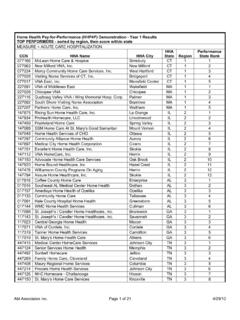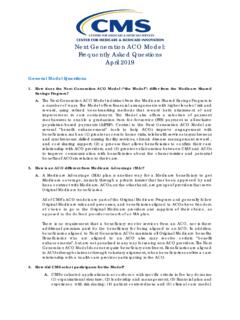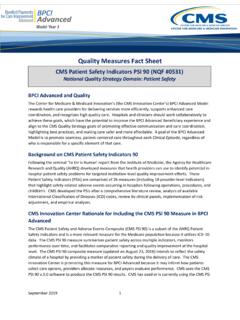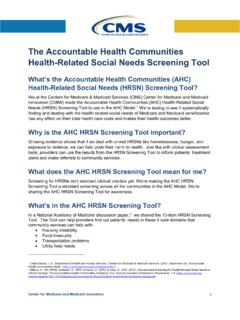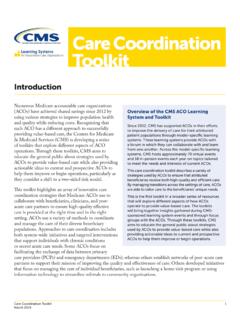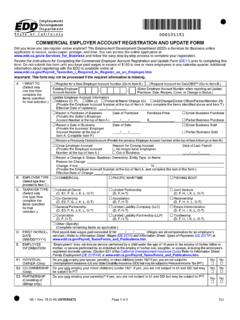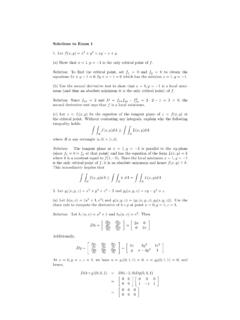Transcription of BPCI Advanced Target Price Specifications Model Years 1 and 2
1 Target Price Specifications Model Years 1 and 2 Centers for Medicare & Medicaid Services (CMS) Center for Medicare & Medicaid Innovation (I nnovation Center) February 2018 BPCI Advanced Target Price Specifications Model Years 1 & 2 | February 2018 ii TABLE OF CONTENTS 1 Inputs .. 1 2 Target Price Overview .. 3 3 Clinical Episode Construction Background .. 5 4 Steps In Target Price Construction .. 7 Patient and Peer Group Risk 7 Patient Case Mix Adjusters .. 7 Peer 8 Estimate Model of Clinical Episode-Level 10 Obtain ACH and PGP Target Prices .. 15 Formulation of the Preliminary Hospital Benchmark Price .. 16 Formulation of the Preliminary PGP-ACH Benchmark Price .. 18 Create Preliminary and Final Target Prices.
2 21 LIST OF TABLES Table 1: Target Price and Setting-Specific Update Factor Datasets .. 1 Table 2: Patient Characteristics Categories used to Risk Adjust BPCI Advanced Target 7 Table 3: Peer Group Characteristics used to Construct BPCI Advanced Target Prices .. 9 Table 4: Clinical Episode Category Level Participant Eligibility Examples .. 11 Table 5: Model Estimation - PCMA Input Calculation .. 13 Table 6: Model Estimation - PAT Factor Input Calculations .. 14 Table 7: Model Estimation - SBS Input Calculations .. 15 Table 8: Preliminary HBP Calculation .. 17 Table 9: Components of the Preliminary HBP .. 17 Table 10: Preliminary PGP-ACH Benchmark Price Calculation .. 20 Table 11: Components of the PGP-ACH Benchmark Price .. 20 Table 12: Preliminary ACH Target Price Calculation.
3 21 Table 13: Preliminary PGP-ACH Target Price Calculation .. 21 BPCI Advanced Target Price Specifications Model Years 1 & 2 | February 2018 1 1 INPUTS Table 1: Target Price and Setting-Specific Update Factor Datasets # Name Source Description Target Price Datasets 1 BPCI Advanced National Clinical Episodes BPCI Advanced Clinical Episode Specifications Document The national set of Clinical Episodes, constructed using the methodology described in the Specifications document. Additional inputs to this file include: Common Working File (CWF), Medicare Enrollment Database (EDB), and Official CMS Standardized Allowed Amounts. 2 BPCI Advanced Participant List CMS The Participant List identifies the Convener, ACH and PGP Participants in the BPCI Advanced Model .
4 3 Provider of Service (POS) Files The Provider of Services (POS) Extract is created from the QIES (Quality Improvement Evaluation System) database as of second quarter 2011 and all future POS files. The file contains an individual record for each Medicare-approved provider and is updated quarterly. The file includes information for all institutional providers, Ambulatory Surgical Centers (ASCs), and Clinical Laboratories. 4 Provider Specific Files (PSF) The file contains information about the facts specific to the provider that affect computations for Prospective Payment Systems. 5 Academic Medical Center (AMC) List CMS The official list of AMCs was created by CMS, along with publicly available listings from the American Association of Academic Medical Centers (AAMC) and teams of clinicians.
5 6 Common Medicare Environment (CME) CMS The CME contains comprehensive data on individuals in the Medicare program. It provides information on insurance coverage and Medicare health plan and demonstration programs in addition to information about Medicare Parts A,B,C and non- subsidy Part D beneficiaries. 7 Long Term Minimum Dataset (MDS) CMS This file includes information on beneficiaries that are institutionalized long term. Setting-Specific Price Update Datasets 8 Inpatient Prospective Payment System (IPPS) Base Rates and MS-DRG Weights These inputs are used to update historical prices for the IPPS setting. BPCI Advanced Target Price Specifications Model Years 1 & 2 | February 2018 2 # Name Source Description 9 Geographic Practice Cost Index (GPCI), Relative Value Units (RVU), County/Locality Crosswalk, and Physician and Anesthesia Conversion Factors (CF) GPCI : RVU/Physician CF: Anesthesia CF: These inputs are used to update historical prices for the PFS setting.
6 10 Inpatient Rehabilitation Facility ( IRF) Conversion Factor (most recent only) See Table 4 These inputs are used to update historical prices for the IRF setting. 11 Medicare Economic Index (MEI) (most recent only) The MEI is used to update historical prices for the Other setting. 12 Skilled Nursing Facility ( SNF) Resource Utilization Group (RUG) weights See Tables 4 and 5 These inputs are used to update historical prices for the SNF setting. 13 Home Health Agency (HHA) base rates and Home Health Resource Group (HHRG) weights (most recent only) These inputs are used to update historical prices for the HHA setting. 14 Addendum B and J from the Outpatient Prospective Payment System (OPPS) Final Rule These inputs are used to update historical prices for the OPPS setting.
7 BPCI Advanced Target Price Specifications Model Years 1 & 2 | February 2018 3 2 Target Price OVERVIEW The following document describes the methodology used to calculate Target Prices for the BPCI Advanced Model . The BPCI Advanced initiative Target Prices are constructed to satisfy the following essential features: Encourage both high and low cost providers to participate; Reward Participants improvement over time; Adjust for patient case mix that is not under the control of providers; Allow for trends in Clinical Episode spending that are distinct according to providers regions and other relevant provider characteristics; and Induce Medicare savings while maintaining high quality care. To satisfy these essential features, the BPCI Advanced Benchmark Price methodology incorporates both regional and historical pricing.
8 The methodology brings these elements together to provide both those Participants who have been historically efficient and those who have been historically inefficient with an incentive to lower costs over time and to benefit from the financial incentives of the BPCI Advanced , as defined in Step 8 of Section , refers to lower Clinical Episode spending, relative to other Episode Initiators, for Clinical Episodes with the same patient and peer group characteristics. The methodology achieves this by benchmarking Participants against other providers with (i) patient populations with similar levels of expenditure risk and (ii) similar hospital-level characteristics, henceforth referred to as peer groups are defined by the list of peer group characteristics within the regression models, as opposed to distinct groups delineated by a single characteristic.
9 See section for more information. The methodology produces Benchmark Prices, represented in official CMS standardized allowed amounts, for acute care hospital (ACH) Participants and for physician group practice (PGP) Participants, each with three components that are multiplied to produce the Benchmark Price . Since PGPs will initiate Clinical Episodes at ACHs, PGP Benchmark Prices build upon ACH Benchmark Prices to account for the fact that PGPs can initiate Clinical Episodes at multiple ACHs. The Hospital Benchmark Price (henceforth, HBP) is comprised of the following components, each of which is described in detail later in this document: Standardized Baseline Spending (SBS): This component accounts for the historical efficiency of ACHs in the baseline period by calculating risk- and peer-standardized Clinical Episode spending in the baseline period.
10 1 2 BPCI Advanced Target Price Specifications Model Years 1 & 2 | February 2018 4 Patient Case Mix Adjustment (PCMA): This component adjusts for varying levels of severity in ACHs patient case mix that are outside the control of ACHs. Peer Adjusted Trend (PAT) factor: This component (i) adjusts for persistent differences in Clinical Episode spending levels across ACH peer groups and (ii) trends each peer group s Clinical Episode spending to the Model Year3 Since separate Target Prices are not provided for Model Years 1 (2018 Q4) and 2, the single set of prices will be trended to Model year 2. based on trends in Clinical Episode spending during the baseline period within each ACH peer group.
